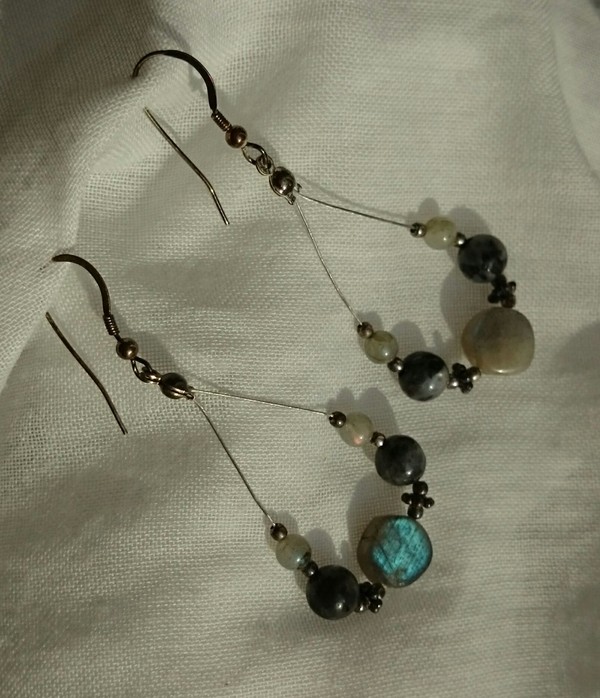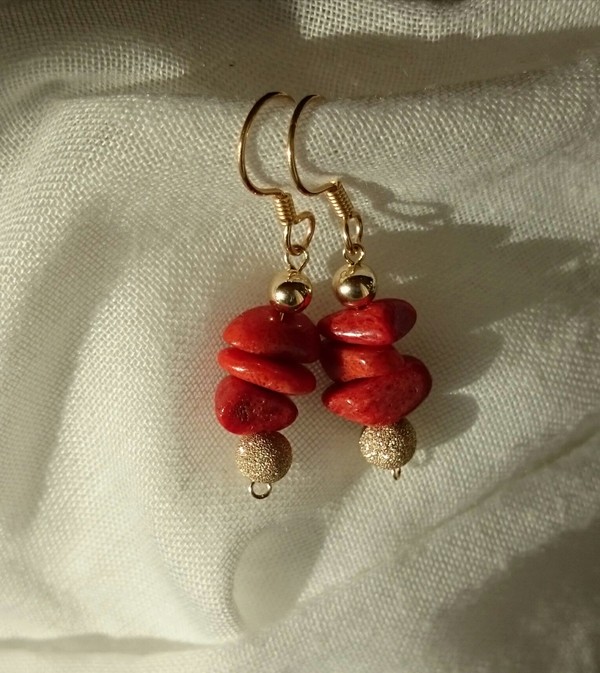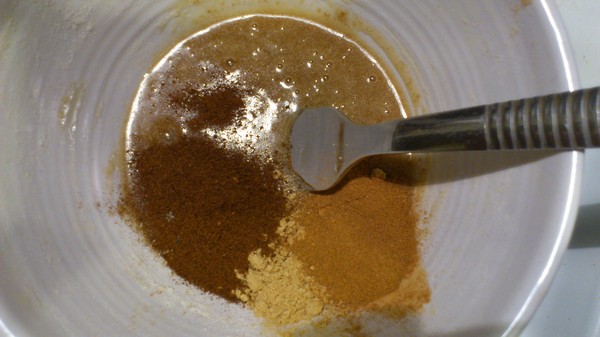Personligt
De smycken jag skapar har alla en människa därute någonstans som de ska till, som de hör till. Det är en stor glädje när de hittar hem! Hoppas några får komma hem till jul :-D 🎄🎁🌠
Sv del 3
När jag skapar smycken är det på ren inspiration. En av de roligaste delarna av processen är att få se vad det blir!
Smycken är något personligt, tycker jag....och det är tillfredsställande att veta att jag är ensam om mina. Även när jag gör beställningar måste det finnas ett element av fritt skapade för att det ska bli bra. Kom gärna med idéer!!

17. Ängsblomma. Grön jade, rhodonit, rosenkvarts, silver, oxiderat silver. 130 kr
Smyckeverkstad del 2
Jag gillar verkligen svartnat silver - det ser lite äkta ut, älskat och använt. De flesta smycken går dock att få blankputsade om så önskas.

9. Fruit drops. Citrin, akvamarin, peridot, rosa turmalin, silver. 280 kr

10. Skimmer. SÅLDA
Labradorit, larvikit, svartnat silver. Båda stensorterna tillhör månstensfamiljen och reflekterar ljus i regnbågens alla färger i vissa vinklar. Ett blänk fick jag med på bilden... 110 kr

11. Orangeröd korall, guld på mässingsbas. 120 kr

12. Rosett. Rosaröd korall, mjölkkvarts, howlit, silver. 230 kr

13. Tjärn. Fuchsit med rubin, serpentin, grön aventurin m fl. 310 kr

14. Moder Jord. Mookait, opalit m fl. 180 kr

15. Himmel. Blå bandagat, sodalit, glaspärlor, silver. 210 kr

16. Brun aventurin, bergskristall. 110 kr
Smyckeverkstad
Jag älskar att tillverka smycken! Det är som att vara barn igen, men betydligt roligare än pärlplattor.
En del av produktionen säljer jag. Det är lika roligt när ett smycke hittar till rätt person som det är att skapa!


Alla smycken är gjorda av äkta stenar/kristaller och silver, eller guld på mässingsbas. Allergisäkra, alltså :-) De flesta har namn.
1. Årstiderna (ovan) labradorit, howlit, hematit, citrin, granat. 220 kr







2. Skog. Grön jade, rosenkvarts, rosa turmalin, granat. 240 kr

3. Sand. Gul jade, gul jaspis. 170 kr

4. Rötter. SÅLT
Bronzit, granat, röd korall, breccijaspis. Sålt

5. Grace. Howlit, mookait, bergskristall. 180 kr

6. Vårflod! Serpentin, lapis lazuli, bergskristall (färgad). 190 kr

7. Syren. Serpentin och ametist. 190 kr
Mera kommer inom kort!
Är du intresserad av ett smycke, kontakta mig på
Några snabba
Hur är det, uttalar du r-et i början av orden frisör och program - egentligen?
Skulle du ge pengar till en tiggare som satt i en relativt sett bekväm fällstol på gatan?
Har du känt genuin kärlek för någon eller något idag?
På banan igen! Eller?
Varje ögonblick är så NU, att jag ju aldrig egentligen kan göra ett påstående om något varaktigt. Men nu, i det nu när den här raden skrivs, är jag på bloggbanan igen, tack vare min vän Anders som har en fantastisk förmåga att inspirera mig!
Fascinerande, hur många tankar som kan storma genom ett huvud samtidigt. Eller snarare genom ett medvetande, för vad har jag för bevis för att det sker inom min skalle? Hjärnan tar säkert emot en massa mätbara impulser som kan betecknas som tankar, men större delen av det som en tanke "är" har kontakt med mitt medvetande, som i sig är något betydligt mer omfattande än hjärnan - känner jag.
Min avsikt när jag satte mig för att blogga nu, var att byta inriktning på bloggandet - helst skapa en helt ny, men det blev för meckigt idag.
Som ni som känner mig vet, hoppar jag från ämne till ämne fort, för varje associationskedja i mitt huvud utvecklas i hög hastighet och förgrenas vilt... vilket kan göra det svårt att hänga med, har jag förstått.
Antagligen kommer jag ibland att redigera text här för att underlätta för eventuella läsare, men lika ofta kanske jag låter det flöda bara för att det är härligt. Jag skriver ju för min egen skull. Och då kommer jag plötsligt tillbaka till det jag från början tänkt skriva om - gillar dessa loopar! - nämligen det intressanta faktum att Alla Alltid bara pratar om Sig Själva.
Vad tänker du när du läser det? Håller du med? Ska vi starta en FB-grupp mot egoism kanske..... nej. Visst är man ofta sitt eget favoritämne i en diskussion, men jag tänker på det faktum att varje varelse på vår planet har valt att ta formen av ett individuellt medvetande, på lek, och så har vi alla de andra som medspelare. Eller motspelare, beroende på hur man ser det. Vi upplever allt genom våra ögon, vår erfarenhet, vårt åsiktsfilter, vilket borgar för att allt vi säger, tycker och gör handlar om oss - det finns ingen faktisk objektivitet, även om det är ett kul begrepp.
Allt vi möter omkring oss speglar något i oss.
Leker man lite med den tanken kan man uppleva ganska många spännande saker.

Är socker giftigt?
Artikel från New York Times 2011. Jag har kortat ned den, för den var ganska pratig.
Is Sugar Toxic?
By GARY TAUBES
Published: April 13, 2011
On May 26, 2009, Robert Lustig gave a lecture called “Sugar: The Bitter Truth,” which was posted on YouTube the following July. Since then, it has been viewed well over 800,000 times, gaining new viewers at a rate of about 50,000 per month, fairly remarkable numbers for a 90-minute discussion of the nuances of fructose biochemistry and human physiology.
Lustig is a specialist on pediatric hormone disorders and the leading expert in childhood obesity at the University of California, San Francisco, School of Medicine, which is one of the best medical schools in the country. He published his first paper on childhood obesity a dozen years ago, and he has been treating patients and doing research on the disorder ever since.
“It’s not about the calories,” he says. “It has nothing to do with the calories. Sugar is a poison by itself.”
If Lustig is right, then our excessive consumption of sugar is the primary reason that the numbers of obese and diabetic Americans have skyrocketed in the past 30 years. But his argument implies more than that. If Lustig is right, it would mean that sugar is also the likely dietary cause of several other chronic ailments widely considered to be diseases of Western lifestyles — heart disease, hypertension and many common cancers among them.
If I didn’t buy this argument myself, I wouldn’t be writing about it here. And I also have a disclaimer to acknowledge. I’ve spent much of the last decade doing journalistic research on diet and chronic disease — some of the more contrarian findings, on dietary fat, appeared in this magazine —– and I have come to conclusions similar to Lustig’s.
So let’s start by clarifying a few issues, beginning with Lustig’s use of the word “sugar” to mean both sucrose — beet and cane sugar, whether white or brown — and high-fructose corn syrup.
In the early 1980s, high-fructose corn syrup replaced sugar in sodas and other products in part because refined sugar then had the reputation as a generally noxious nutrient. High-fructose corn syrup was portrayed by the food industry as a healthful alternative, and that’s how the public perceived it.
But marketing aside, the two sweeteners are effectively identical in their biological effects.
The question, then, isn’t whether high-fructose corn syrup is worse than sugar; it’s what do they do to us, and how do they do it? The conventional wisdom has long been that the worst that can be said about sugars of any kind is that they cause tooth decay and represent “empty calories” that we eat in excess because they taste so good.
Those organizations that now advise us to cut down on our sugar consumption do so for this reason. Refined sugar and H.F.C.S. don’t come with any protein, vitamins, minerals, antioxidants or fiber, and so they either displace other more nutritious elements of our diet or are eaten over and above what we need to sustain our weight, and this is why we get fatter.
Lustig’s argument, however, is not about the consumption of empty calories — and biochemists have made the same case previously, though not so publicly. It is that sugar has unique characteristics, specifically in the way the human body metabolizes the fructose in it, that may make it singularly harmful, at least if consumed in sufficient quantities.
The phrase Lustig uses when he describes this concept is “isocaloric but not isometabolic.” This means we can eat 100 calories of glucose (from a potato or bread or other starch) or 100 calories of sugar (half glucose and half fructose), and they will be metabolized differently and have a different effect on the body. The calories are the same, but the metabolic consequences are quite different.
The fructose component of sugar and H.F.C.S. is metabolized primarily by the liver, while the glucose from sugar and starches is metabolized by every cell in the body. Consuming sugar (fructose and glucose) means more work for the liver than if you consumed the same number of calories of starch (glucose). And if you take that sugar in liquid form — soda or fruit juices — the fructose and glucose will hit the liver more quickly than if you consume them, say, in an apple (or several apples, to get what researchers would call the equivalent dose of sugar). The speed with which the liver has to do its work will also affect how it metabolizes the fructose and glucose.
In animals, or at least in laboratory rats and mice, it’s clear that if the fructose hits the liver in sufficient quantity and with sufficient speed, the liver will convert much of it to fat. This apparently induces a condition known as insulin resistance, which is now considered the fundamental problem in obesity, and the underlying defect in heart disease and in the type of diabetes, type 2, that is common to obese and overweight individuals. It might also be the underlying defect in many cancers.
If what happens in laboratory rodents also happens in humans, and if we are eating enough sugar to make it happen, then we are in trouble.
Until Lustig came along, the last time an academic forcefully put forward the sugar-as-toxin thesis was in the 1970s, when John Yudkin, a leading authority on nutrition in the United Kingdom, published a polemic on sugar called “Sweet and Dangerous.” Through the 1960s Yudkin did a series of experiments feeding sugar and starch to rodents, chickens, rabbits, pigs and college students. He found that the sugar invariably raised blood levels of triglycerides (a technical term for fat), which was then, as now, considered a risk factor for heart disease. Sugar also raised insulin levels in Yudkin’s experiments, which linked sugar directly to type 2 diabetes. Few in the medical community took Yudkin’s ideas seriously, largely because he was also arguing that dietary fat and saturated fat were harmless. This set Yudkin’s sugar hypothesis directly against the growing acceptance of the idea, prominent to this day, that dietary fat was the cause of heart disease, a notion championed by the University of Minnesota nutritionist Ancel Keys.
A common assumption at the time was that if one hypothesis was right, then the other was most likely wrong. Either fat caused heart disease by raising cholesterol, or sugar did by raising triglycerides. “The theory that diets high in sugar are an important cause of atherosclerosis and heart disease does not have wide support among experts in the field, who say that fats and cholesterol are the more likely culprits,” as Jane E. Brody wrote in The Times in 1977.
At the time, many of the key observations cited to argue that dietary fat caused heart disease actually support the sugar theory as well. During the Korean War, pathologists doing autopsies on American soldiers killed in battle noticed that many had significant plaques in their arteries, even those who were still teenagers, while the Koreans killed in battle did not. The atherosclerotic plaques in the Americans were attributed to the fact that they ate high-fat diets and the Koreans ate low-fat. But the Americans were also eating high-sugar diets, while the Koreans, like the Japanese, were not.
In 1970, Keys published the results of a landmark study in nutrition known as the Seven Countries Study. Its results were perceived by the medical community and the wider public as compelling evidence that saturated-fat consumption is the best dietary predictor of heart disease. But sugar consumption in the seven countries studied was almost equally predictive. So it was possible that Yudkin was right, and Keys was wrong, or that they could both be right. The evidence has always been able to go either way.
What has changed since then, other than Americans getting fatter and more diabetic? It wasn’t so much that researchers learned anything particularly new about the effects of sugar or high-fructose corn syrup in the human body. Rather the context of the science changed: physicians and medical authorities came to accept the idea that a condition known as metabolic syndrome is a major, if not the major, risk factor for heart disease and diabetes.
The first symptom doctors are told to look for in diagnosing metabolic syndrome is an expanding waistline. This means that if you’re overweight, there’s a good chance you have metabolic syndrome, and this is why you’re more likely to have a heart attack or become diabetic (or both) than someone who’s not. Although lean individuals, too, can have metabolic syndrome, and they are at greater risk of heart disease and diabetes than lean individuals without it.
Having metabolic syndrome is another way of saying that the cells in your body are actively ignoring the action of the hormone insulin — a condition known technically as being insulin-resistant. Because insulin resistance and metabolic syndrome still get remarkably little attention in the press (certainly compared with cholesterol), let me explain the basics.
You secrete insulin in response to the foods you eat — particularly the carbohydrates — to keep blood sugar in control after a meal. When your cells are resistant to insulin, your body (your pancreas, to be precise) responds to rising blood sugar by pumping out more and more insulin. Eventually the pancreas can no longer keep up with the demand or it gives in to what diabetologists call “pancreatic exhaustion.” Now your blood sugar will rise out of control, and you’ve got diabetes.
Not everyone with insulin resistance becomes diabetic; some continue to secrete enough insulin to overcome their cells’ resistance to the hormone. But having chronically elevated insulin levels has harmful effects of its own — heart disease, for one. A result is higher triglyceride levels and blood pressure, lower levels of HDL cholesterol (the “good cholesterol”), further worsening the insulin resistance — this is metabolic syndrome.
When physicians assess your risk of heart disease these days, they will take into consideration your LDL cholesterol (the bad kind), but also these symptoms of metabolic syndrome.
There are several hypotheses, but researchers who study the mechanisms of insulin resistance now think that a likely cause is the accumulation of fat in the liver. When studies have been done trying to answer this question in humans, says Varman Samuel, who studies insulin resistance at Yale School of Medicine, the correlation between liver fat and insulin resistance in patients, lean or obese, is “remarkably strong.” What it looks like, Samuel says, is that “when you deposit fat in the liver, that’s when you become insulin-resistant.”
That raises the other obvious question: What causes the liver to accumulate fat in humans? A common assumption is that simply getting fatter leads to a fatty liver, but this does not explain fatty liver in lean people. Some of it could be attributed to genetic predisposition. But there’s also the very real possibility that it is caused by sugar.
By the early 2000s, researchers studying fructose metabolism had established certain findings unambiguously and had well-established biochemical explanations for what was happening. Feed animals enough pure fructose or enough sugar, and their livers convert the fructose into fat — the saturated fatty acid, palmitate, to be precise, that supposedly gives us heart disease when we eat it, by raising LDL cholesterol. The fat accumulates in the liver, and insulin resistance and metabolic syndrome follow.
These changes can happen in as little as a week if the animals are fed sugar or fructose in huge amounts — 60 or 70 percent of the calories in their diets. They can take several months if the animals are fed something closer to what humans (in America) actually consume — around 20 percent of the calories in their diet. Stop feeding them the sugar, in either case, and the fatty liver promptly goes away, and with it the insulin resistance.
Similar effects can be shown in humans, although the researchers doing this work typically did the studies with only fructose— and pure fructose is not the same thing as sugar or high-fructose corn syrup. When Tappy fed his human subjects the equivalent of the fructose in 8 to 10 cans of Coke or Pepsi a day — a “pretty high dose,” he says —– their livers would start to become insulin-resistant, and their triglycerides would go up in just a few days. With lower doses, the same effects would appear, but it would take longer, a month or more.
Despite the steady accumulation of research, the evidence can still be criticized as falling far short of conclusive. The studies in rodents aren’t necessarily applicable to humans. And the kinds of studies that Tappy, Havel and Stanhope did — having real people drink beverages sweetened with fructose and comparing the effect with what happens when the same people or others drink beverages sweetened with glucose — aren’t applicable to real human experience, because we never naturally consume pure fructose. We always take it with glucose, in the nearly 50-50 combinations of sugar or high-fructose corn syrup. And then the amount of fructose or sucrose being fed in these studies, to the rodents or the human subjects, has typically been enormous.
This is why the research reviews on the subject invariably conclude that more research is necessary to establish at what dose sugar and high-fructose corn syrup start becoming what Lustig calls toxic. At present, short-term-intervention studies, however, suggest that a high-fructose intake consisting of soft drinks, sweetened juices or bakery products can increase the risk of metabolic and cardiovascular diseases.”
In simpler language, how much of this stuff do we have to eat or drink, and for how long, before it does to us what it does to laboratory rats? And is that amount more than we’re already consuming?
Lustig and his colleagues at U.C.S.F. are doing one of these studies. It will look at what happens when obese teenagers consume no sugar other than what they might get in fruits and vegetables. Another study will do the same with pregnant women to see if their babies are born healthier and leaner.
Only one study in this country, by Havel and Stanhope at the University of California, Davis, is directly addressing the question of how much sugar is required to trigger the symptoms of insulin resistance and metabolic syndrome. Havel and Stanhope are having healthy people drink three sugar- or H.F.C.S.-sweetened beverages a day and then seeing what happens. The catch is that their study subjects go through this three-beverage-a-day routine for only two weeks. That doesn’t seem like a very long time — only 42 meals, not 1,000 — but Havel and Stanhope have been studying fructose since the mid-1990s, and they seem confident that two weeks is sufficient to see if these sugars cause at least some of the symptoms of metabolic syndrome.
So the answer to the question of whether sugar is as bad as Lustig claims is that it certainly could be.
What are the chances that sugar is actually worse than Lustig says it is?
One of the diseases that increases in incidence with obesity, diabetes and metabolic syndrome is cancer. This is why I said earlier that insulin resistance may be a fundamental underlying defect in many cancers, as it is in type 2 diabetes and heart disease. The connection between obesity, diabetes and cancer was first reported in 2004 in large population studies by researchers from the World Health Organization’s International Agency for Research on Cancer. It is not controversial. What it means is that you are more likely to get cancer if you’re obese or diabetic than if you’re not, and you’re more likely to get cancer if you have metabolic syndrome than if you don’t.
This goes along with two other observations that have led to the well-accepted idea that some large percentage of cancers are caused by our Western diets and lifestyles. This means they could actually be prevented if we could pinpoint exactly what the problem is and prevent or avoid that.
One observation is that death rates from cancer, like those from diabetes, increased significantly in the second half of the 19th century and the early decades of the 20th.
The second observation was that malignant cancer, like diabetes, was a relatively rare disease in populations that didn’t eat Western diets, and in some of these populations it appeared to be virtually nonexistent.
Now most researchers will agree that the link between Western diet or lifestyle and cancer manifests itself through this association with obesity, diabetes and metabolic syndrome — i.e., insulin resistance.
So how does it work? Cancer researchers now consider that the problem with insulin resistance is that it leads us to secrete more insulin, and insulin (as well as a related hormone known as insulin-like growth factor) actually promotes tumor growth.
The cells of many human cancers come to depend on insulin to provide the fuel (blood sugar) and materials they need to grow and multiply. Insulin and insulin-like growth factor (and related growth factors) also provide the signal, in effect, to do it. The more insulin, the better they do. Some cancers develop mutations that serve the purpose of increasing the influence of insulin on the cell; others take advantage of the elevated insulin levels that are common to metabolic syndrome, obesity and type 2 diabetes. Some do both.
Lewis Cantley at Harvard Medical School, says that up to 80 percent of all human cancers are driven by either mutations or environmental factors that work to enhance or mimic the effect of insulin on the incipient tumor cells.
Sugar scares me , obviously. If sugar just makes us fatter, that’s one thing. We start gaining weight, we eat less of it. But we are also talking about things we can’t see — fatty liver, insulin resistance and all that follows. Officially I’m not supposed to worry because the evidence isn’t conclusive, but I do.
Gary Taubes ([email protected]) is a Robert Wood Johnson Foundation independent investigator in health policy and the author of “Why We Get Fat.” Editor: Vera Titunik ([email protected]).
Is Sugar Toxic?
By GARY TAUBES
Published: April 13, 2011
On May 26, 2009, Robert Lustig gave a lecture called “Sugar: The Bitter Truth,” which was posted on YouTube the following July. Since then, it has been viewed well over 800,000 times, gaining new viewers at a rate of about 50,000 per month, fairly remarkable numbers for a 90-minute discussion of the nuances of fructose biochemistry and human physiology.
Lustig is a specialist on pediatric hormone disorders and the leading expert in childhood obesity at the University of California, San Francisco, School of Medicine, which is one of the best medical schools in the country. He published his first paper on childhood obesity a dozen years ago, and he has been treating patients and doing research on the disorder ever since.
“It’s not about the calories,” he says. “It has nothing to do with the calories. Sugar is a poison by itself.”
If Lustig is right, then our excessive consumption of sugar is the primary reason that the numbers of obese and diabetic Americans have skyrocketed in the past 30 years. But his argument implies more than that. If Lustig is right, it would mean that sugar is also the likely dietary cause of several other chronic ailments widely considered to be diseases of Western lifestyles — heart disease, hypertension and many common cancers among them.
If I didn’t buy this argument myself, I wouldn’t be writing about it here. And I also have a disclaimer to acknowledge. I’ve spent much of the last decade doing journalistic research on diet and chronic disease — some of the more contrarian findings, on dietary fat, appeared in this magazine —– and I have come to conclusions similar to Lustig’s.
So let’s start by clarifying a few issues, beginning with Lustig’s use of the word “sugar” to mean both sucrose — beet and cane sugar, whether white or brown — and high-fructose corn syrup.
In the early 1980s, high-fructose corn syrup replaced sugar in sodas and other products in part because refined sugar then had the reputation as a generally noxious nutrient. High-fructose corn syrup was portrayed by the food industry as a healthful alternative, and that’s how the public perceived it.
But marketing aside, the two sweeteners are effectively identical in their biological effects.
The question, then, isn’t whether high-fructose corn syrup is worse than sugar; it’s what do they do to us, and how do they do it? The conventional wisdom has long been that the worst that can be said about sugars of any kind is that they cause tooth decay and represent “empty calories” that we eat in excess because they taste so good.
Those organizations that now advise us to cut down on our sugar consumption do so for this reason. Refined sugar and H.F.C.S. don’t come with any protein, vitamins, minerals, antioxidants or fiber, and so they either displace other more nutritious elements of our diet or are eaten over and above what we need to sustain our weight, and this is why we get fatter.
Lustig’s argument, however, is not about the consumption of empty calories — and biochemists have made the same case previously, though not so publicly. It is that sugar has unique characteristics, specifically in the way the human body metabolizes the fructose in it, that may make it singularly harmful, at least if consumed in sufficient quantities.
The phrase Lustig uses when he describes this concept is “isocaloric but not isometabolic.” This means we can eat 100 calories of glucose (from a potato or bread or other starch) or 100 calories of sugar (half glucose and half fructose), and they will be metabolized differently and have a different effect on the body. The calories are the same, but the metabolic consequences are quite different.
The fructose component of sugar and H.F.C.S. is metabolized primarily by the liver, while the glucose from sugar and starches is metabolized by every cell in the body. Consuming sugar (fructose and glucose) means more work for the liver than if you consumed the same number of calories of starch (glucose). And if you take that sugar in liquid form — soda or fruit juices — the fructose and glucose will hit the liver more quickly than if you consume them, say, in an apple (or several apples, to get what researchers would call the equivalent dose of sugar). The speed with which the liver has to do its work will also affect how it metabolizes the fructose and glucose.
In animals, or at least in laboratory rats and mice, it’s clear that if the fructose hits the liver in sufficient quantity and with sufficient speed, the liver will convert much of it to fat. This apparently induces a condition known as insulin resistance, which is now considered the fundamental problem in obesity, and the underlying defect in heart disease and in the type of diabetes, type 2, that is common to obese and overweight individuals. It might also be the underlying defect in many cancers.
If what happens in laboratory rodents also happens in humans, and if we are eating enough sugar to make it happen, then we are in trouble.
Until Lustig came along, the last time an academic forcefully put forward the sugar-as-toxin thesis was in the 1970s, when John Yudkin, a leading authority on nutrition in the United Kingdom, published a polemic on sugar called “Sweet and Dangerous.” Through the 1960s Yudkin did a series of experiments feeding sugar and starch to rodents, chickens, rabbits, pigs and college students. He found that the sugar invariably raised blood levels of triglycerides (a technical term for fat), which was then, as now, considered a risk factor for heart disease. Sugar also raised insulin levels in Yudkin’s experiments, which linked sugar directly to type 2 diabetes. Few in the medical community took Yudkin’s ideas seriously, largely because he was also arguing that dietary fat and saturated fat were harmless. This set Yudkin’s sugar hypothesis directly against the growing acceptance of the idea, prominent to this day, that dietary fat was the cause of heart disease, a notion championed by the University of Minnesota nutritionist Ancel Keys.
A common assumption at the time was that if one hypothesis was right, then the other was most likely wrong. Either fat caused heart disease by raising cholesterol, or sugar did by raising triglycerides. “The theory that diets high in sugar are an important cause of atherosclerosis and heart disease does not have wide support among experts in the field, who say that fats and cholesterol are the more likely culprits,” as Jane E. Brody wrote in The Times in 1977.
At the time, many of the key observations cited to argue that dietary fat caused heart disease actually support the sugar theory as well. During the Korean War, pathologists doing autopsies on American soldiers killed in battle noticed that many had significant plaques in their arteries, even those who were still teenagers, while the Koreans killed in battle did not. The atherosclerotic plaques in the Americans were attributed to the fact that they ate high-fat diets and the Koreans ate low-fat. But the Americans were also eating high-sugar diets, while the Koreans, like the Japanese, were not.
In 1970, Keys published the results of a landmark study in nutrition known as the Seven Countries Study. Its results were perceived by the medical community and the wider public as compelling evidence that saturated-fat consumption is the best dietary predictor of heart disease. But sugar consumption in the seven countries studied was almost equally predictive. So it was possible that Yudkin was right, and Keys was wrong, or that they could both be right. The evidence has always been able to go either way.
What has changed since then, other than Americans getting fatter and more diabetic? It wasn’t so much that researchers learned anything particularly new about the effects of sugar or high-fructose corn syrup in the human body. Rather the context of the science changed: physicians and medical authorities came to accept the idea that a condition known as metabolic syndrome is a major, if not the major, risk factor for heart disease and diabetes.
The first symptom doctors are told to look for in diagnosing metabolic syndrome is an expanding waistline. This means that if you’re overweight, there’s a good chance you have metabolic syndrome, and this is why you’re more likely to have a heart attack or become diabetic (or both) than someone who’s not. Although lean individuals, too, can have metabolic syndrome, and they are at greater risk of heart disease and diabetes than lean individuals without it.
Having metabolic syndrome is another way of saying that the cells in your body are actively ignoring the action of the hormone insulin — a condition known technically as being insulin-resistant. Because insulin resistance and metabolic syndrome still get remarkably little attention in the press (certainly compared with cholesterol), let me explain the basics.
You secrete insulin in response to the foods you eat — particularly the carbohydrates — to keep blood sugar in control after a meal. When your cells are resistant to insulin, your body (your pancreas, to be precise) responds to rising blood sugar by pumping out more and more insulin. Eventually the pancreas can no longer keep up with the demand or it gives in to what diabetologists call “pancreatic exhaustion.” Now your blood sugar will rise out of control, and you’ve got diabetes.
Not everyone with insulin resistance becomes diabetic; some continue to secrete enough insulin to overcome their cells’ resistance to the hormone. But having chronically elevated insulin levels has harmful effects of its own — heart disease, for one. A result is higher triglyceride levels and blood pressure, lower levels of HDL cholesterol (the “good cholesterol”), further worsening the insulin resistance — this is metabolic syndrome.
When physicians assess your risk of heart disease these days, they will take into consideration your LDL cholesterol (the bad kind), but also these symptoms of metabolic syndrome.
There are several hypotheses, but researchers who study the mechanisms of insulin resistance now think that a likely cause is the accumulation of fat in the liver. When studies have been done trying to answer this question in humans, says Varman Samuel, who studies insulin resistance at Yale School of Medicine, the correlation between liver fat and insulin resistance in patients, lean or obese, is “remarkably strong.” What it looks like, Samuel says, is that “when you deposit fat in the liver, that’s when you become insulin-resistant.”
That raises the other obvious question: What causes the liver to accumulate fat in humans? A common assumption is that simply getting fatter leads to a fatty liver, but this does not explain fatty liver in lean people. Some of it could be attributed to genetic predisposition. But there’s also the very real possibility that it is caused by sugar.
By the early 2000s, researchers studying fructose metabolism had established certain findings unambiguously and had well-established biochemical explanations for what was happening. Feed animals enough pure fructose or enough sugar, and their livers convert the fructose into fat — the saturated fatty acid, palmitate, to be precise, that supposedly gives us heart disease when we eat it, by raising LDL cholesterol. The fat accumulates in the liver, and insulin resistance and metabolic syndrome follow.
These changes can happen in as little as a week if the animals are fed sugar or fructose in huge amounts — 60 or 70 percent of the calories in their diets. They can take several months if the animals are fed something closer to what humans (in America) actually consume — around 20 percent of the calories in their diet. Stop feeding them the sugar, in either case, and the fatty liver promptly goes away, and with it the insulin resistance.
Similar effects can be shown in humans, although the researchers doing this work typically did the studies with only fructose— and pure fructose is not the same thing as sugar or high-fructose corn syrup. When Tappy fed his human subjects the equivalent of the fructose in 8 to 10 cans of Coke or Pepsi a day — a “pretty high dose,” he says —– their livers would start to become insulin-resistant, and their triglycerides would go up in just a few days. With lower doses, the same effects would appear, but it would take longer, a month or more.
Despite the steady accumulation of research, the evidence can still be criticized as falling far short of conclusive. The studies in rodents aren’t necessarily applicable to humans. And the kinds of studies that Tappy, Havel and Stanhope did — having real people drink beverages sweetened with fructose and comparing the effect with what happens when the same people or others drink beverages sweetened with glucose — aren’t applicable to real human experience, because we never naturally consume pure fructose. We always take it with glucose, in the nearly 50-50 combinations of sugar or high-fructose corn syrup. And then the amount of fructose or sucrose being fed in these studies, to the rodents or the human subjects, has typically been enormous.
This is why the research reviews on the subject invariably conclude that more research is necessary to establish at what dose sugar and high-fructose corn syrup start becoming what Lustig calls toxic. At present, short-term-intervention studies, however, suggest that a high-fructose intake consisting of soft drinks, sweetened juices or bakery products can increase the risk of metabolic and cardiovascular diseases.”
In simpler language, how much of this stuff do we have to eat or drink, and for how long, before it does to us what it does to laboratory rats? And is that amount more than we’re already consuming?
Lustig and his colleagues at U.C.S.F. are doing one of these studies. It will look at what happens when obese teenagers consume no sugar other than what they might get in fruits and vegetables. Another study will do the same with pregnant women to see if their babies are born healthier and leaner.
Only one study in this country, by Havel and Stanhope at the University of California, Davis, is directly addressing the question of how much sugar is required to trigger the symptoms of insulin resistance and metabolic syndrome. Havel and Stanhope are having healthy people drink three sugar- or H.F.C.S.-sweetened beverages a day and then seeing what happens. The catch is that their study subjects go through this three-beverage-a-day routine for only two weeks. That doesn’t seem like a very long time — only 42 meals, not 1,000 — but Havel and Stanhope have been studying fructose since the mid-1990s, and they seem confident that two weeks is sufficient to see if these sugars cause at least some of the symptoms of metabolic syndrome.
So the answer to the question of whether sugar is as bad as Lustig claims is that it certainly could be.
What are the chances that sugar is actually worse than Lustig says it is?
One of the diseases that increases in incidence with obesity, diabetes and metabolic syndrome is cancer. This is why I said earlier that insulin resistance may be a fundamental underlying defect in many cancers, as it is in type 2 diabetes and heart disease. The connection between obesity, diabetes and cancer was first reported in 2004 in large population studies by researchers from the World Health Organization’s International Agency for Research on Cancer. It is not controversial. What it means is that you are more likely to get cancer if you’re obese or diabetic than if you’re not, and you’re more likely to get cancer if you have metabolic syndrome than if you don’t.
This goes along with two other observations that have led to the well-accepted idea that some large percentage of cancers are caused by our Western diets and lifestyles. This means they could actually be prevented if we could pinpoint exactly what the problem is and prevent or avoid that.
One observation is that death rates from cancer, like those from diabetes, increased significantly in the second half of the 19th century and the early decades of the 20th.
The second observation was that malignant cancer, like diabetes, was a relatively rare disease in populations that didn’t eat Western diets, and in some of these populations it appeared to be virtually nonexistent.
Now most researchers will agree that the link between Western diet or lifestyle and cancer manifests itself through this association with obesity, diabetes and metabolic syndrome — i.e., insulin resistance.
So how does it work? Cancer researchers now consider that the problem with insulin resistance is that it leads us to secrete more insulin, and insulin (as well as a related hormone known as insulin-like growth factor) actually promotes tumor growth.
The cells of many human cancers come to depend on insulin to provide the fuel (blood sugar) and materials they need to grow and multiply. Insulin and insulin-like growth factor (and related growth factors) also provide the signal, in effect, to do it. The more insulin, the better they do. Some cancers develop mutations that serve the purpose of increasing the influence of insulin on the cell; others take advantage of the elevated insulin levels that are common to metabolic syndrome, obesity and type 2 diabetes. Some do both.
Lewis Cantley at Harvard Medical School, says that up to 80 percent of all human cancers are driven by either mutations or environmental factors that work to enhance or mimic the effect of insulin on the incipient tumor cells.
Sugar scares me , obviously. If sugar just makes us fatter, that’s one thing. We start gaining weight, we eat less of it. But we are also talking about things we can’t see — fatty liver, insulin resistance and all that follows. Officially I’m not supposed to worry because the evidence isn’t conclusive, but I do.
Gary Taubes ([email protected]) is a Robert Wood Johnson Foundation independent investigator in health policy and the author of “Why We Get Fat.” Editor: Vera Titunik ([email protected]).
Livets mening
“When I was 5 years old, my mother always told me that happiness was the key to life. When I went to school, they asked me what I wanted to be when I grew up. I wrote down ‘happy’. They told me I didn’t understand the assignment, and I told them they didn’t understand life.” (John Lennon)
Goda nyheter gillar vi!!
http://www.svt.se/nyheter/regionalt/vasterbottensnytt/ljus-kur-i-busskur
Språk är aldrig statiskt
Hmmmm..... jag noterar att det inte heter klackskor längre, utan det svengelska klackar. Åtminstone i skrift.
Det heter inte "Var bor du? heller, utan "vart bor du".
Uttrycken "ta vara på" och "ta tillvara" har slagits samman och blivit "ta tillvara på".
"Han satte sig i hans bil" betyder numera "han satte sig i sin bil".
"Sin egen" har trängts ut av "sin egna".
Mumma för en språkpolis men det tjänar inget till. Det är bara så det är.
:-)
Heja Ricky!
Några bilder
Var och plockade lärk-kottar till julpyssel idag. Vi var där förra året, Castro! Ska bli en slags krans till dörren, kanske. Vackert gult av barr på backen under.

Julen står för dörren - i vår lägenhet. Lördag it is!! Lille mannen är i full gång.


Och så fort en sats är utbakad, står jag där och rör i skålen....t



...till nästa

Nostalgi :-)

Det kanske kan verka knasigt, men jag njuter av nostalgin att gå förbi här nästan varje dag. Skulle nog ha uppskattat det lika mycket även om jag inte hade bott där de där magiska åren när jag var liten, men då på ett annat sätt. Det är så vackert, så härligt backigt och krokigt, och så de stora träden...
Glädjande prylar

Gillar dessa skarpt. Finns på Lagerhaus, men liknande säkert på fler ställen. Inte dyrt heller - 19 kr för blyertspennorna, 39 för bläckpennorna. Bonus - dekorera dem själv!
Apropå blyerts: det är en total myt att de innehåller bly och är farliga att tugga på. Stiftet är av grafit; kol, helt enkelt. :-)
